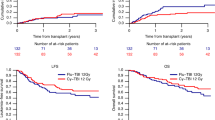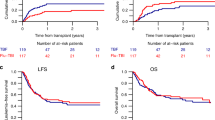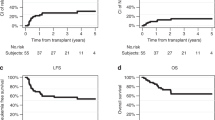Abstract
In this prospective study, we examined the toxicity and efficacy of an intensified conditioning regimen for treatment of patients with relapsed or high-risk acute lymphoblastic leukemia who undergo allogeneic hematopoietic stem cell transplantation. Fifteen patients received fludarabine 30 mg/m2, cytarabine 2000 mg/m2, amsacrine 100 mg/m2 on days -10, -9, -8 and -7, anti-thymocyte globulin (ATG-Fresenius) 20 mg/kg body weight on days -6, -5 and -4 and fractionated total body irradiation 2 × 2 Gy on days -3, -2 and -1 (FLAMSA-ATG-TBI) before allogeneic hematopoietic stem cell transplantation. At the time of hematopoietic stem cell transplantation, 10 patients were in complete remission (8 CR1; 2 CR2), 3 with primary refractory and 2 suffered from refractory relapse. All patients achieved a complete remission after hematopoietic stem cell transplantation; and after a median follow-up time of 1091 days (range, 334–1554 days), nine patients (60%) are alive and free from disease, including three patients with prior refractory disease. Three patients died due to treatment-related mortality. The most frequent and severe conditioning-related toxicities observed in 9 out of 15 patients were grade III/IV infections according to common toxicity criteria. Thus, conditioning with the FLAMSA-ATG-TBI regimen is a feasible and effective alternative for patients with relapsed or high-risk acute lymphoblastic leukemia.
This is a preview of subscription content, access via your institution
Access options
Subscribe to this journal
Receive 12 print issues and online access
$259.00 per year
only $21.58 per issue
Buy this article
- Purchase on SpringerLink
- Instant access to full article PDF
Prices may be subject to local taxes which are calculated during checkout

Similar content being viewed by others
References
Freund M, Diedrich H, Ganser A, Gramatzki M, Heil G, Heyll A et al. Treatment of relapsed or refractory adult acute lymphocytic leukemia. Cancer 1992; 69: 709–716.
Koller CA, Kantarjian HM, Thomas D, O'Brien S, Rios MB, Kornblau S et al. The hyper-CVAD regimen improves outcome in relapsed acute lymphoblastic leukemia. Leukemia 1997; 11: 2039–2044.
Martino R, Bellido M, Brunet S, Altes A, Sureda A, Guardia R et al. Intensive salvage chemotherapy for primary refractory or first relapsed adult acute lymphoblastic leukemia: results of a prospective trial. Haematologica 1999; 84: 505–510.
Thomas DA, Kantarjian H, Smith TL, Koller C, Cortes J, O'Brien S et al. Primary refractory and relapsed adult acute lymphoblastic leukemia: characteristics, treatment results, and prognosis with salvage therapy. Cancer 1999; 86: 1216–1230.
Thomas X, Danaila C, Le QH, Sebban C, Troncy J, Charrin C et al. Long-term follow-up of patients with newly diagnosed adult acute lymphoblastic leukemia: a single institution experience of 378 consecutive patients over a 21-year period. Leukemia 2001; 15: 1811–1822.
De Angulo G, Yuen C, Palla SL, Anderson PM, Zweidler-McKay PA . Absolute lymphocyte count is a novel prognostic indicator in ALL and AML: implications for risk stratification and future studies. Cancer 2008; 112: 407–415.
Pullarkat V, Slovak ML, Kopecky KJ, Forman SJ, Appelbaum FR . Impact of cytogenetics on the outcome of adult acute lymphoblastic leukemia: results of Southwest Oncology Group 9400 study. Blood 2008; 111: 2563–2572.
Thomas X, Le QH . Prognostic factors in adult acute lymphoblastic leukemia. Hematology 2003; 8: 233–242.
Andreeff M, Gaynor J, Chapman D, Little C, Gee T, Clarkson BD . Prognostic factors in acute lymphoblastic leukemia in adults: the Memorial Hospital experience. Haematol Blood Transfus 1987; 30: 111–124.
Gaynor J, Chapman D, Little C, McKenzie S, Miller W, Andreeff M et al. A cause-specific hazard rate analysis of prognostic factors among 199 adults with acute lymphoblastic leukemia: the Memorial Hospital experience since 1969. J Clin Oncol 1988; 6: 1014–1030.
Gulati SC, Gaynor J, Esseesse I, Gee T, Little C, Andreeff M et al. Use of prognostic factors in deciding therapy for adult acute lymphoblastic leukemia: new approaches at Memorial Sloan-Kettering Cancer Center (MSKCC). Bone Marrow Transplant 1989; 4 (Suppl 1): 86–89.
Hoelzer D, Thiel E, Loffler H, Buchner T, Ganser A, Heil G et al. Prognostic factors in a multicenter study for treatment of acute lymphoblastic leukemia in adults. Blood 1988; 71: 123–131.
Goldstone AH, Richards SM, Lazarus HM, Tallman MS, Buck G, Fielding AK et al. In adults with standard-risk acute lymphoblastic leukemia, the greatest benefit is achieved from a matched sibling allogeneic transplantation in first complete remission, and an autologous transplantation is less effective than conventional consolidation/maintenance chemotherapy in all patients: final results of the International ALL Trial (MRC UKALL XII/ECOG E2993). Blood 2008; 111: 1827–1833.
Labar B, Suciu S, Zittoun R, Muus P, Marie JP, Fillet G et al. Allogeneic stem cell transplantation in acute lymphoblastic leukemia and non-Hodgkin's lymphoma for patients <or=50 years old in first complete remission: results of the EORTC ALL-3 trial. Haematologica 2004; 89: 809–817.
Ribera JM, Oriol A, Bethencourt C, Parody R, Hernandez-Rivas JM, Moreno MJ et al. Comparison of intensive chemotherapy, allogeneic or autologous stem cell transplantation as post-remission treatment for adult patients with high-risk acute lymphoblastic leukemia. Results of the PETHEMA ALL-93 trial. Haematologica 2005; 90: 1346–1356.
Marks DI, Forman SJ, Blume KG, Perez WS, Weisdorf DJ, Keating A et al. A comparison of cyclophosphamide and total body irradiation with etoposide and total body irradiation as conditioning regimens for patients undergoing sibling allografting for acute lymphoblastic leukemia in first or second complete remission. Biol Blood Marrow Transplant 2006; 12: 438–453.
Jamieson CH, Amylon MD, Wong RM, Blume KG . Allogeneic hematopoietic cell transplantation for patients with high-risk acute lymphoblastic leukemia in first or second complete remission using fractionated total-body irradiation and high-dose etoposide: a 15-year experience. Exp Hematol 2003; 31: 981–986.
Giebel S, Krawczyk-Kulis M, Adamczyk-Cioch M, Jakubas B, Palynyczko G, Lewandowski K et al. Fludarabine, cytarabine, and mitoxantrone (FLAM) for the treatment of relapsed and refractory adult acute lymphoblastic leukemia. A phase study by the Polish Adult Leukemia Group (PALG). Ann Hematol 2006; 85: 717–722.
Hashmi KU, Khan B, Ahmed P, Raza S, Hussain I, Mahmood A et al. FLAG-IDA in the treatment of refractory/relapsed acute leukaemias: single centre study. J Pak Med Assoc 2005; 55: 234–238.
Specchia G, Pastore D, Carluccio P, Liso A, Mestice A, Rizzi R et al. FLAG-IDA in the treatment of refractory/relapsed adult acute lymphoblastic leukemia. Ann Hematol 2005; 84: 792–795.
Schmid C, Schleuning M, Ledderose G, Tischer J, Kolb HJ . Sequential regimen of chemotherapy, reduced-intensity conditioning for allogeneic stem-cell transplantation, and prophylactic donor lymphocyte transfusion in high-risk acute myeloid leukemia and myelodysplastic syndrome. J Clin Oncol 2005; 23: 5675–5687.
Schmid C, Schleuning M, Hentrich M, Markl GE, Gerbitz A, Tischer J et al. High antileukemic efficacy of an intermediate intensity conditioning regimen for allogeneic stem cell transplantation in patients with high-risk acute myeloid leukemia in first complete remission. Bone Marrow Transplant 2008; 41: 721–727.
Gokbuget N, Hoelzer D, Arnold R, Bohme A, Bartram CR, Freund M et al. Treatment of adult ALL according to protocols of the German Multicenter Study Group for Adult ALL (GMALL). Hematol Oncol Clin North Am 2000; 14: 1307–1325, ix.
Gokbuget N, Raff R, Brugge-Mann M, Flohr T, Scheuring U, Pfeifer H et al. Risk/MRD adapted GMALL trials in adult ALL. Ann Hematol 2004; 83 (Suppl 1): S129–S131.
Hoelzer D, Arnold R, Bartram CR, Bohme A, Freund M, Ganser A et al. Acute lymphatic leukemia in the adult. Diagnosis, risk groups and therapy. Internist (Berl) 2002; 43: 1212–1222, 1224.
Glucksberg H, Storb R, Fefer A, Buckner CD, Neiman PE, Clift RA et al. Clinical manifestations of graft-versus-host disease in human recipients of marrow from HL-A-matched sibling donors. Transplantation 1974; 18: 295–304.
Przepiorka D, Weisdorf D, Martin P, Klingemann HG, Beatty P, Hows J et al. 1994 Consensus Conference on Acute GVHD Grading. Bone Marrow Transplant 1995; 15: 825–828.
Czibere A, Bruns I, Graef T, Fenk R, Zohren F, Safaian N et al. Treatment of severe hemorrhagic cystitis after allogeneic stem cell transplantation with palifermin, a recombinant human keratinocyte growth factor. Biol Blood Marrow Transplant 2007; 13: 872–874.
Chim CS, Lie AK, Liang R, Au WY, Kwong YL . Long-term results of allogeneic bone marrow transplantation for 108 adult patients with acute lymphoblastic leukemia: favorable outcome with BMT at first remission and HLA-matched unrelated donor. Bone Marrow Transplant 2007; 40: 339–347.
Yanada M, Matsuo K, Suzuki T, Naoe T . Allogeneic hematopoietic stem cell transplantation as part of postremission therapy improves survival for adult patients with high-risk acute lymphoblastic leukemia: a metaanalysis. Cancer 2006; 106: 2657–2663.
Thomas X, Boiron JM, Huguet F, Dombret H, Bradstock K, Vey N et al. Outcome of treatment in adults with acute lymphoblastic leukemia: analysis of the LALA-94 trial. J Clin Oncol 2004; 22: 4075–4086.
Jillella AP, Doria R, Khan K, Zelterman D, Ahmad YH, Smith BR et al. Cyclophosphamide, cytosine arabinoside and TBI as a conditioning regimen for allogeneic bone marrow transplantation in patients with leukemia. Bone Marrow Transplant 1999; 23: 1095–1100.
Kumar M, Saleh A, Rao PV, Ochoa S, Meyers L, Miller A et al. Toxicity associated with high-dose cytosine arabinoside and total body irradiation as conditioning for allogeneic bone marrow transplantation. Bone Marrow Transplant 1997; 19: 1061–1064.
Shigematsu A, Kondo T, Yamamoto S, Sugita J, Onozawa M, Kahata K et al. Excellent outcome of allogeneic hematopoietic stem cell transplantation using a conditioning regimen with medium-dose VP-16, cyclophosphamide and total-body irradiation for adult patients with acute lymphoblastic leukemia. Biol Blood Marrow Transplant 2008; 14: 568–575.
Gandhi V, Robertson LE, Keating MJ, Plunkett W . Combination of fludarabine and arabinosylcytosine for treatment of chronic lymphocytic leukemia: clinical efficacy and modulation of arabinosylcytosine pharmacology. Cancer Chemother Pharmacol 1994; 34: 30–36.
Suki S, Kantarjian H, Gandhi V, Estey E, O'Brien S, Beran M et al. Fludarabine and cytosine arabinoside in the treatment of refractory or relapsed acute lymphocytic leukemia. Cancer 1993; 72: 2155–2160.
Arlin ZA, Feldman E, Kempin S, Ahmed T, Mittelman A, Savona S et al. Amsacrine with high-dose cytarabine is highly effective therapy for refractory and relapsed acute lymphoblastic leukemia in adults. Blood 1988; 72: 433–435.
Grigg AP, Szer J, Beresford J, Dodds A, Bradstock K, Durrant S et al. Factors affecting the outcome of allogeneic bone marrow transplantation for adult patients with refractory or relapsed acute leukaemia. Br J Haematol 1999; 107: 409–418.
Duerst RE, Horan JT, Liesveld JL, Abboud CN, Zwetsch LM, Senf ES et al. Allogeneic bone marrow transplantation for children with acute leukemia: cytoreduction with fractionated total body irradiation, high-dose etoposide and cyclophosphamide. Bone Marrow Transplant 2000; 25: 489–494.
Giralt SA, LeMaistre CF, Vriesendorp HM, Andersson BS, Dimopoulos M, Gajewski J et al. Etoposide, cyclophosphamide, total-body irradiation, and allogeneic bone marrow transplantation for hematologic malignancies. J Clin Oncol 1994; 12: 1923–1930.
Shigematsu A, Kondo T, Yamamoto S, Sugita J, Onozawa M, Kahata K et al. Excellent outcome of allogeneic hematopoietic stem cell transplantation using a conditioning regimen with medium-dose VP-16, cyclophosphamide and total-body irradiation for adult patients with acute lymphoblastic leukemia. Biol Blood Marrow Transplant 2008; 14: 568–575.
Marks DI, Perez WS, He W, Zhang MJ, Bishop MR, Bolwell BJ et al. Unrelated donor transplants in adults with Philadelphia-negative acute lymphoblastic leukemia in first complete remission. Blood 2008; 112: 426–434.
Author information
Authors and Affiliations
Corresponding author
Rights and permissions
About this article
Cite this article
Zohren, F., Czibere, A., Bruns, I. et al. Fludarabine, amsacrine, high-dose cytarabine and 12 Gy total body irradiation followed by allogeneic hematopoietic stem cell transplantation is effective in patients with relapsed or high-risk acute lymphoblastic leukemia. Bone Marrow Transplant 44, 785–792 (2009). https://doi.org/10.1038/bmt.2009.83
Received:
Revised:
Accepted:
Published:
Issue date:
DOI: https://doi.org/10.1038/bmt.2009.83
Keywords
This article is cited by
-
Anti-thymocyte globulin could improve the outcome of allogeneic hematopoietic stem cell transplantation in patients with highly aggressive T-cell tumors
Blood Cancer Journal (2015)
-
Single center experience with total body irradiation and melphalan (TBI-MEL) myeloablative conditioning regimen for allogeneic stem cell transplantation (SCT) in patients with refractory hematologic malignancies
Annals of Hematology (2014)
-
Allo-HSCT for acute leukemia of ambiguous lineage in adults: the comparison between standard conditioning and intensified conditioning regimens
Annals of Hematology (2013)
-
Idarubicin-intensified BUCY2 regimens may lower relapse rate and improve survival in patients undergoing allo-SCT for high-risk hematological malignancies: a retrospective analysis
Bone Marrow Transplantation (2012)



